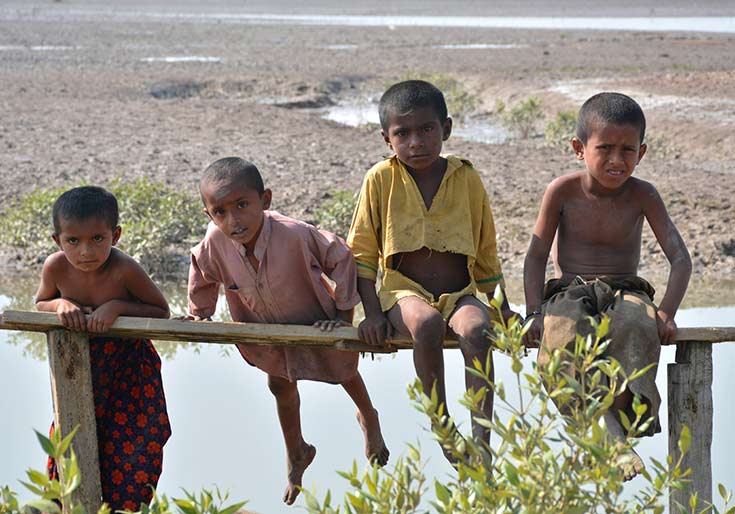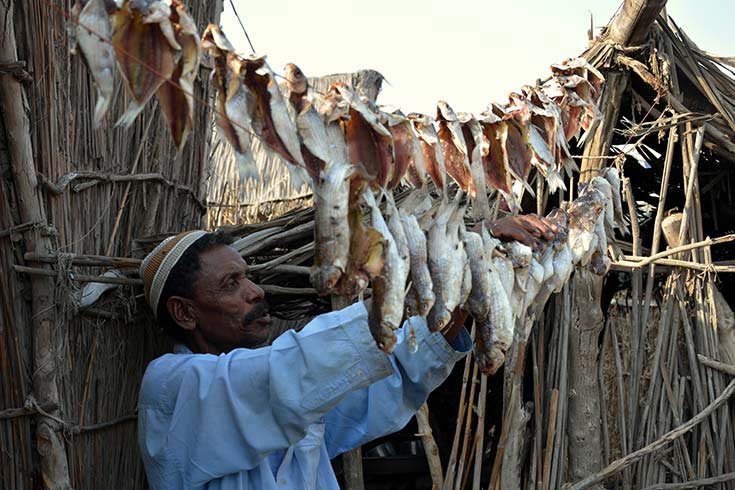Pakistan: River Indus delta women's saga
Sea level rise as a result of climate change is destroying Pakistan's River Indus delta and water scarcity is becoming a major issue in the region. The deltaic communities, especially women, are the worst affected in the prevailing scenario, writes Amar Guriro

Elderly Hayat Bibi recalls her childhood and says that the area was famous for its agricultural products and there was abundant freshwater in the river (Photo by Amar Guriro)
The Indus Delta has been is in trouble, and the people within it even more so. The villages, built mostly by the locals, are scattered on either sides of different creeks of the river.
These creeks were once flowing with water, but that has changed. After a marked reduction in the flow of water – along with sea level rise – as a result of climate change, seawater now flows upstream in these creeks. River water eludes the area people completely, but the upward trend has turned even the groundwater saline.
The deltaic region of the River Indus is one of the most vulnerable to climate change in Pakistan. It suffers continuous sea erosion, sea level rise, sea intrusion and faces an increasing threat of cyclones from the Arabian Sea.
The prevailing conditions mean that deltaic communities can no longer find fresh water sources for their consumption and use. There is little water to drink, much less for anything else.
Like many other parts of the world, in this region too, it is the women have to bear the burden of the water crisis.
Every day, thousands of women, mostly from poor households, walk miles to collect water in the region. In most of the villages scattered along the deltaic region of River Indus Delta, the nearest water source to any single household is between one to three kilometres away, at least. Each woman in these settlements has to make at least five trips a day to these water sources, which means each of them have to walk between five to 15 kilometres a day to collect water with a pot or pitcher on their head. One run can fetch them around 10 to 15 litres of water, but that is 10-15 litres of load they carry singlehandedly each time.
Almost half their day is spent walking back and forth to fetch water for their families. This means less time for their children, their education or health.

Girls of the Mithi Goth village collect water: Settlements in the deltaic areas are suffering from acute water shortages and girls have to learn to collect and store water from an early age (Photo by Amar Guriro)
Noor Jahan, in her early 30s, is already a mother to six, with a fifth child on the way. She fits a metal pot onto her head and drags her five months pregnant body to and from the watershed, making seven trips in a short span of time. The water is for her family.
Her mother Zeenat Bibi worries for her health and that of the child and has come over to help. Her husband Ali Dad is out looking to catch some fish, while Noor looks after the children, cooks the food, and collects, manages and stores the water.

She lives in a village near the Garho town in the Thatta district of Pakistan's southern Sindh province, which is the last district on the River Indus. Spread over 11,400 square miles or 29,524 square kilometres, and ranked as the world's sixth largest delta, the fan-shaped delta of River Indus forms an extensive system of mudflats, estuaries, creeks and marshes.
Noor’s story is shared by many women, including Jooran Mallah, who lives in Goth Allahdino Pateel, another deltaic village near Kharo Chhan, one of the 17 major creeks of River Indus. Thirty year old Jooran is a mother to six, and had a miscarriage after she slipped on a pond while filling her bucket.
She is pregnant again. Like other women in the area, water continues to be her responsibility, despite the risks to her health. She is four months pregnant, but she is not spared from the task of collecting water and washing clothes.
"Who else will wash clothes or fetch water?" she asks.
She says that a small watercourse near their colony filled up with dirty water owing to heavy rains in August last year. They have no other option but to continue to use this water because the next water source is five kilometres away. “But I can’t walk so far so we make do with this contaminated water,” she explains.
Children playing near their house on Tipan Island in the deltaic region of River Indus in southern Pakistan. In the absence of freshwater sources on their island, most children do not bathe for several days (Photo by Amar Guriro)
The water shortage in the area is so severe that keeping livestock is out of the question for many. In Pakistan, especially in the rural areas, livestock doubles as livelihood and nutrition.
“In last ten to fifteen years, the area has entirely changed. The fields where we used to grow rice have become completely infertile and we cannot even grow grass for our livestock there. Keeping a cow or a goat is simply not possible,” said Ramzan Mallah while pointing at a barren land near his village.
According to the locals, most of the deltaic area was once fertile. Villagers would grow their famous red rice, sugarcane, wheat and other crops, and tended their herds of sheep, goats and cows. The Kharai buffalo was a famous breed for milk and almost everyone had one in their homes.
The situation becomes precarious for women who almost always rely on their male counterparts for survival. Decision-making is not a rural woman’s domain and without real opportunities to earn or manage a livelihood, their situation is worsening.
The prevailing conditions have also pushed many to migrate from the area entirely, leaving behind those who do not have the option to do so.
Angler Muhammad Sultan and his elder brother were packed and ready to leave when I spoke to them. As they were waiting for the loader to pick up their belongings and move them away, they said: “There is nothing here and the area has no vegetation. Even for everyday use vegetables, we have to go to Thatta, which is around 80 kilometres away from our village. There’s no water to drink here and our lives are miserable, which is why we decided to migrate.” He added that the situation has worsened in the past few years but previously, they found a means to survive through fishing.

Allah Dino checks his dried fish. Most residents in the deltaic region are fishermen but the dwindling fish catch has made their life miserable (Photo by Amar Guriro)
“But now there is no fish. We need powerful motorboats and labour to go to the open sea for fishing, which we can't afford," he added.
"More than three million acres of fertile deltaic land has been submerged with seawater in last two decades, due to which more than 800,000 indigenous residents of Indus Delta have migrated to other areas," claimed Muhammad Ali Shah, chairman Pakistan Fisher folk Forum, an NGO working for the betterment of anglers.
As is the case in many developing countries, when men begin to migrate looking for means to survive it is often the women who get left behind. If and when a man has the means and resources to bring his family out of these areas he can, otherwise the options are fairly limited.
Like Sultan, many families are ready to leave the area, but they are reluctant to leave their native places, as they are poor and cannot afford to migrate to a new place and start a new life.
Women have their work cut out for them, but without adequate help, they cannot battle the drought and famine that threaten to wipe the population off of the deltaic areas completely.
Amar Guriro is a journalist based in Pakistan. He covers environmental issues extensively and has worked on several issues relating to the Indus Delta.This blog on Pakistan is led and curated by Luavut Zahid
Amar Guriro, 25/01/2016